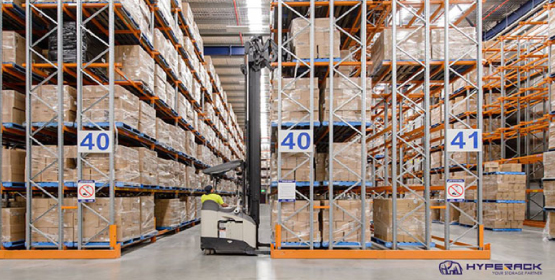How to Optimize Your Warehouse Layout for Racking Systems
Wiki Article
Optimizing your warehouse layout is crucial for increasing productivity, improving safety, and maximizing the effectiveness of your Warehouse Racking System. A well-organized warehouse layout allows for smooth operations, reduces downtime, and enhances the ability to manage inventory efficiently. In this article, we’ll explore how to optimize your warehouse layout to make the most out of your racking systems while ensuring the best operational outcomes.
The Importance of a Well-Designed Warehouse Layout
A poorly designed warehouse layout can lead to unnecessary delays, damaged products, and inefficiencies in inventory handling. On the other hand, an optimized layout minimizes travel time, enhances the flow of goods, reduces errors, and improves safety. Warehouse racking systems are key components of an efficient layout because they impact how goods are stored, accessed, and rotated.
To understand more about the structure and usage of racking systems, refer to the Wikipedia article on pallet racking.
Steps to Optimize Your Warehouse Layout for Racking Systems
Follow these key steps to ensure your warehouse layout complements your racking system and improves operational efficiency.
1. Assess Your Inventory and Storage Needs
The first step in optimizing your warehouse layout is to assess the types of products you store and their movement patterns. Consider the following:
- What are the sizes and weights of the products?
- How frequently are products accessed (fast-moving or slow-moving)?
- What is the required stock rotation method (FIFO or LIFO)?
By understanding these factors, you can select the appropriate racking system (e.g., selective, drive-in, pallet flow) and allocate space efficiently.
2. Plan the Flow of Materials
Material flow is the movement of goods throughout the warehouse, from receiving to storage, picking, packing, and shipping. An optimized layout minimizes unnecessary movement and creates clear paths for workers and equipment. The general flow should follow this sequence:
- Receiving
- Storage
- Order picking
- Shipping
This setup reduces travel time, minimizes bottlenecks, and ensures a smooth, continuous process that increases efficiency. Design your racking system with this flow in mind, ensuring that frequently picked items are easily accessible.
3. Maximize Vertical Space
Don’t limit your storage space to the horizontal area of the warehouse. Use vertical space by installing tall racking systems. Modern racking solutions like high-rise selective racks, drive-in racks, and mezzanine systems help you take full advantage of vertical storage, increasing the overall storage capacity of your warehouse.
4. Consider Aisle Width and Forklift Access
Your aisle width should balance storage density and equipment accessibility. Narrow aisle systems can maximize space, but ensure that forklifts and material handling equipment can navigate without difficulty. Narrow aisles are ideal for high-density racking, but they require specialized equipment like Very Narrow Aisle (VNA) forklifts.
5. Implement Safety Standards
Safety is a top priority in warehouse design. Ensure that your layout and racking system adhere to local and international safety standards. This includes proper aisle width, clear signage, emergency exits, and safeguards like rack protectors to reduce the risk of forklift collisions. Make sure your racking systems are properly anchored and level to prevent collapses.
6. Allow for Future Scalability
A good warehouse layout should accommodate future growth. As your business expands, you may need to add more racking systems or modify existing ones. Select modular racking systems that allow for flexibility and easy reconfiguration as your storage needs evolve.
7. Integrate Warehouse Management Systems (WMS)
A Warehouse Management System (WMS) plays an essential role in tracking inventory and optimizing operations. Integrating your racking system with WMS technology helps improve stock visibility, order accuracy, and real-time inventory tracking. Consider using barcode scanning or RFID technology to automate stock monitoring and ensure seamless integration with your racking system.
Common Warehouse Layout Strategies for Racking Systems
Depending on the size and needs of your warehouse, there are several layout strategies to choose from. Here are a few common ones:
1. Grid Layout
The grid layout is the most common and straightforward approach, where racking units are arranged in rows with aisles in between. It is ideal for warehouses that store a variety of products and need easy access to every pallet.
2. U-Shaped Layout
In the U-shaped layout, goods are received at one end, stored in the middle, and shipped out from the opposite end. This layout promotes a smooth flow of goods and minimizes unnecessary movement.
3. Flow Layout
The flow layout creates a direct, continuous path for materials to move through receiving, storage, picking, and shipping areas. This design ensures a smooth transition of goods, reduces travel time, and minimizes congestion within the warehouse.
Best Practices for Racking System Layout
Consider these best practices to optimize your racking system layout:
- Group Similar Products Together: Store similar or frequently ordered items close to each other for easy access.
- Use High-Density Racking for Bulk Storage: Systems like pallet flow or drive-in racking maximize storage density for large quantities of the same product.
- Separate Receiving and Shipping Areas: Keep receiving and shipping zones distinct to avoid congestion.
- Plan for Cross-Docking: If your warehouse handles high volumes of incoming shipments, design a cross-docking area to quickly transfer products to outbound vehicles without storing them long-term.
Conclusion
Optimizing your warehouse layout for racking systems is key to achieving efficiency, safety, and scalability. By carefully considering factors like material flow, vertical space, aisle widths, and safety standards, you can create a warehouse layout that maximizes storage capacity, reduces operational costs, and enhances productivity. The right layout combined with an appropriate racking system is an investment in the long-term success of your warehouse operations.
Follow Us on Social Media
Stay updated with the latest trends and solutions for warehouse racking systems by following us on our social media channels:
- Facebook: https://www.facebook.com/hyperack/
- YouTube: https://www.youtube.com/channel/UCdGZlojT4q3f0j9iIqv4OnQ
- TikTok: https://www.tiktok.com/@hyperackofficial
- Instagram: https://www.instagram.com/hyperack/
- Google Map: https://maps.app.goo.gl/8BKAapohN7bsdZmf8
Report this wiki page
